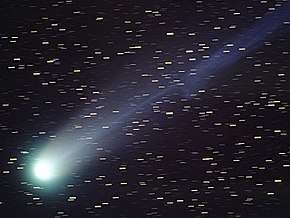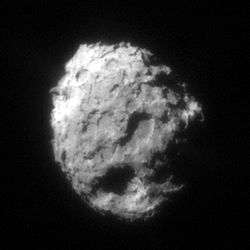Comet Machholz
Comet Machholz, formally designated C/2004 Q2, is a long-period comet discovered by Donald Machholz on August 27, 2004. It reached naked eye brightness in January 2005. Unusual for such a relatively bright comet, its perihelion was farther from the Sun than the Earth's orbit.
 Comet Machholz in February 2005 | |
| Discovery | |
|---|---|
| Discovered by | Donald Machholz |
| Discovery date | 2004 |
| Alternative designations | Comet Machholz |
| Orbital characteristics A | |
| Epoch | 2453415.5 (February 14, 2005) |
| Aphelion | ~1070 AU[1] |
| Perihelion | 1.205 AU |
| Semi-major axis | ~537 AU[1] |
| Eccentricity | 0.9995 |
| Orbital period | 12,400 yr (epoch 2050)[1] |
| Inclination | 38.6° |
| Last perihelion | January 24, 2005 |
| Next perihelion | unknown |
Period

Given the orbital eccentricity of this object, different epochs can generate quite different heliocentric unperturbed two-body best-fit solutions to the aphelion distance (maximum distance) of this object. For objects at such high eccentricity, the Suns barycentric coordinates are more stable than heliocentric coordinates. Using JPL Horizons the barycentric orbital elements for epoch 2050 generate a semi-major axis of 537 AU and a period of approximately 12,400 years.[1] This gives it a barycentric orbital period just a little larger than Sedna.
There are six other long-period comets named Machholz: C/1978 R3 (a.k.a. 1978 XIII, 1978l), C/1985 K1 (a.k.a. 1985 VIII, 1985e), C/1988 P1 (a.k.a. 1988 XV, 1988j), C/1992 N1 (a.k.a. 1992 XVII, 1992k), C/1994 T1 (a.k.a. 1994 XXVII, 1994r), and C/2010 F4. In addition, there are C/1992 F1 (Tanaka-Machholz), C/1994 N1 (Nakamura-Nishimura-Machholz) and C/2018 V1 (Machholz-Fujikawa-Iwamoto).
See also
- 96P/Machholz
- 141P/Machholz and fragments
References
- Horizons output. "Barycentric Osculating Orbital Elements for Comet C/2004 Q2 (Machholz)". Retrieved 2011-02-03. (Solution using the Solar System Barycenter and barycentric coordinates. Select Ephemeris Type:Elements and Center:@0)
External links
- Sky and Telescope — Comet Machholz in the Evening Sky
- Sky and Telescope — Catch Comet Machholz at Its Best
- The Discovery of Comet Machholz (discoverer's personal retelling)
- Gallery of images
- NASA Astronomy Picture of the Day: Announcing Comet Machholz (13 December 2004)
- C/2004 Q2 at the JPL Small-Body Database


